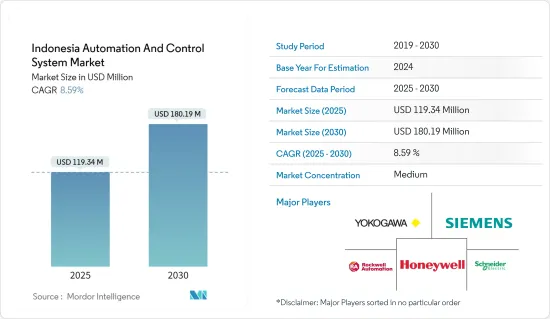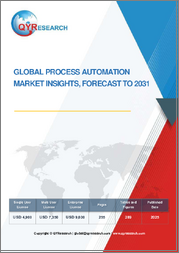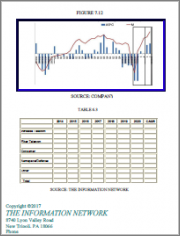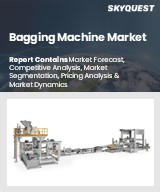
|
시장보고서
상품코드
1642142
인도네시아의 자동화 및 제어 시스템 시장 : 시장 점유율 분석, 산업 동향, 성장 예측(2025-2030년)Indonesia Automation And Control System - Market Share Analysis, Industry Trends & Statistics, Growth Forecasts (2025 - 2030) |
||||||
인도네시아의 자동화 및 제어 시스템 시장 규모는 2025년에 1억 1,934만 달러로 추정되고, 예측 기간(2025-2030년)의 CAGR은 8.59%로 전망되며, 2030년에는 1억 8,019만 달러에 달할 것으로 예측됩니다.

세계 경제와의 융합이 꾸준히 진행되는 인도네시아에서는 자동화 및 제어 시스템이 비용 절감에 필수적입니다.
주요 하이라이트
- 자동화 및 제어 시스템은 제품 및 서비스의 제조 및 유통에 관한 광범위한 프로세스를 감독 및 제어하는 시스템입니다. 조립 라인에서 발전소에 이르기까지 많은 보편적이고 필수적인 서비스는 자동화 및 제어 시스템에 의존합니다. 예를 들어 현대 국가의 사회적, 산업적, 경제적 복리를 유지하는 많은 유틸리티 및 통신 인프라는 자동화 및 제어 시스템에 의존합니다.
- 인도네시아는 자동화를 고도로 도입하는 유명한 산업 제조업체입니다. 제조업은 국가의 GDP에 상당한 금액을 기여하고 있습니다. 예를 들어 인도네시아 통계국에 따르면 2022년 인도네시아 제조업은 국내총생산(GDP)의 18% 이상을 차지했으며, 이 나라의 경제에 가장 큰 공헌을 했습니다. 인도네시아와 말레이시아의 견조한 제조 활동은 연구 시장 수요를 증가시키는 것으로 보입니다.
- 수많은 산업 부문에서 자동화 시스템을 장려하는 정부 자금 증가, 다양한 제조 부문의 자동화에 대한 왕성한 수요, 산업용 로봇의 기술 혁신 증가, 제조 기술 진보의 급증, 인구 증가에 대응하기 위한 대량 생산과 관련 공급망의 필요성이 인도네시아의 자동화 및 프로세스 제어 시스템 시장
- 인도네시아의 광물 자원은 광대하고 미개척이며 주석, 팜유, 일반탄의 세계 최대 수출국입니다. 또한 니켈, 구리, 보크사이트, 고무, 망간, 아연, 납 등 주요 수출국 중 하나입니다. 광업은 인도네시아의 GDP의 약 10분의 1을 차지했으며, 오랜 세월 동안 이 나라의 경제 발전에 중요한 역할을 해왔습니다. 금속 및 광물에 대한 수요가 증가함에 따라 반도체 및 전자 제품 수요가 증가하며 광업 부문에서 자동화 시스템의 채택을 뒷받침하고 있습니다.
- 에너지 부문에서는 스마트 시티 프로그램의 출현으로 자동화 및 제어 시스템에 대한 수요가 증가하고 있습니다. 인도네시아는 도시화의 과제를 다루는 것을 목표로 하는 종합적인 디지털화 프로그램인 '100의 스마트 시티 운동'을 시작하여 이 점에서 주도적인 역할을 담당하고 있습니다. 이 이니셔티브는 도시화 문제를 다루는 정부 계획의 일환으로 2045년까지 인도네시아 인구의 83%가 도시에 거주할 것으로 예상됩니다.
- 인도네시아는 또한 혁신적인 바이오매스 혼합 프로그램을 통해 기존 증기 발전소의 녹화를 개선하기 위해 바이오매스의 사용을 장려하고 있습니다. 이 프로그램은 2025년까지 52개소에서 바이오매스를 섞는 것을 목표로 하고 있으며, 이미 37개소에서 바이오매스를 섞어서 2023년까지 108만 톤의 목표를 달성하기 위해 30만 6,000톤을 사용하고 있습니다. 이러한 프로그램과 이 나라의 전력 및 유틸리티부문을 발전시키기 위한 새로운 프로젝트와 투자는 이 나라에서의 오토메이션 및 제어 시스템 도입의 새로운 시장 기회를 창출할 것으로 기대되고 있습니다.
- 그러나 자동화 및 제어 시스템과 관련된 초기 비용은 높습니다. 커스터마이징과 통합의 복잡성은 전반적인 비용에 박차를 가하고 있습니다. 또한, 자동화 장비를 도입하려면 공장의 기존 인프라를 변경해야 할 수도 있습니다. 여기에는 새로운 장비를 수용하기 위한 레이아웃, 전기 시스템 및 안전 기능의 변경이 포함될 수 있으며 추가 비용이 발생합니다. 이러한 요인이 시장 성장을 방해할 수 있습니다.
인도네시아의 자동화 및 제어 시스템 시장 동향
식음료가 인도네시아의 자동화 및 제어 시스템 시장을 견인
- 식음료 부문은 인도네시아 경제에서 중요한 위치를 차지하고 있으며 국가의 GDP에 필수적인 공헌자로서의 역할을 하고 있습니다. 이 산업은 풍부한 천연 자원과 확대하는 내수로부터 혜택을 받아 그 회복력을 강화하고 있습니다. 특히 2022년 2분기 음료 분야는 비석유 및 가스산업의 GDP의 38.38%를 차지하며 인도네시아 국내에서의 GDP 공헌 면에서 주요 서브분야로서의 지위를 확고히 하고 있습니다.
- 인도네시아 통계국(BPS)의 데이터에 따르면, 식음료(F&B) 산업은 2022년 연간 기준으로 4.90% 증가하여 8,130억 6,200만 IDR이 되었습니다. 이 상황은 식음료 자체 생산량 증가와 불가분입니다. CRIF의 2023년 예측에 따르면, 식품 및 식품 산업은 전년 대비 약 5% 증가할 것으로 예상됩니다. 이 성장에 영향을 미치는 요인으로는 경제환경 변화에 대한 식품 및 음식 산업의 감도가 높습니다. CRIF는 또한 특히 COVID-19 팬데믹성 이후 국가 경제 회복 상황에서 이 산업은 여전히 좋은 전망을 가지고 있다고 생각합니다.
- 2030년까지 인도네시아를 세계의 상위 10경제권에 위치시키는 것을 목표로 하는 'Making Indonesia 4.0' 전략은 사물인터넷(IoT), 자동화, 로봇공학, 인공지능, 센서 기술 등의 중요한 기술을 그 핵심 요소로 자리매김하고 있습니다. 이 전략의 선호 부문 중에서도 음식 및 음료 산업은 두드러집니다. 그 결과 국내 식음료 부문은 디지털 변혁에 대한 수요가 높아지고 자동화와 제어 시스템 증가로 이어질 것으로 예상됩니다. 국가 인더스트리 4.0 산업 전략에 따라 인도네시아 정부는 현지 식음료 산업에 디지털 진보를 받아들이고 제조에 현지 원료를 사용하는 방향으로 전환하도록 촉구하고 있습니다.
- 식품의 안전성은 식품 및 식품 산업에 있어서 매우 중요한 요소이며, COVID-19는 그 중요성을 더욱 향상시키고 있습니다. 제조업체는 식품 안전 대책을 조사하고 강화할 필요가 있습니다. 로봇의 도입은 사람의 개입을 불필요하게 함으로써 식품의 안전성을 향상시키는데 도움이 되어 식품 제조 시설에서의 2차 오염의 위험을 대폭 저감할 수 있습니다. 게다가 인도네시아를 포함한 포장 식품 수요는 세계적으로 급증하고 있으며, 식품 포장 시설에서는 수작업 대신 선진 기계가 도입되고 있습니다.
- 게다가 인도네시아 통계국의 데이터에 의하면, 동국은 Z세대와 밀레니얼 세대의 소비자가 52%를 차지하고 있어, 이들에 대응하기 위해, 기업은 디지털 진화의 면에서 따라잡기 위해 진화·노력하고 있어 오토메이션과 산업 제어 기술 수요에 플러스의 영향을 주고 있습니다. 식음료(F&B) 제조업은 생산과 품질을 향상시키기 위해 IIoT, AI, PLC, 로봇 등의 도구를 도입하고 있습니다. 실시간 데이터 처리 및 예측 분석의 개발은 효과적인 의사 결정을 위해 인사이트를 창출하는 데이터 활용의 새로운 방법의 도입에 더욱 기여하고 있습니다.
DCS가 인도네시아의 자동화 및 제어 시스템 시장에서 우위를 차지
- 분산 제어 시스템(DCS)은 로컬 프로세스의 복잡성을 관리하는 다중 통합 서브시스템을 감독하는 감독 수준 제어를 포함하는 통합 제어 아키텍처입니다. DCS는 주로 석유 및 가스 정제, 석유 생산 등의 공업 프로세스에서 이용되고 있습니다. 이러한 시스템은 제어의 신뢰성과 성능을 향상시키기 위해 중복성과 진단 기능을 갖춘 특별한 설계입니다. 분산된 이산 필드 장치와 그 운영 스테이션을 제어하는 유연성을 향상시킵니다.
- 분산 제어 시스템(DCS)의 확장성은 중요한 이점입니다. 종합적인 통합 시스템으로 초기 도입하거나 필요에 따라 확장할 수 있는 독립형 시스템으로 도입할 수 있습니다. 시장 성장에 긍정적인 영향을 미칠 것으로 예상되는 것은 전력 에너지 부문 수요 증가, 국내 산업 인프라 개척 등입니다.
- DCS Systems는 분산 컨트롤러, 워크스테이션 및 기타 컴퓨팅 요소 간의 피어 투 피어 액세스와 같은 큰 이점을 설명합니다. 석유화학, 원자력, 석유 및 가스 등의 공정 산업에서는 정밀한 제어와 세트 포인트 주변의 공정 허용도를 제공하는 컨트롤러에 대한 수요가 높아지고 있습니다. 인도네시아의 석유 및 가스 섹터에서는 투자가 증가하고 있으며, DCS 용도의 새로운 기회가 탄생하고 있습니다. DCS는 석유 및 가스 산업에서 널리 사용되며 생산 공정 제어를 강화합니다.
- 인도네시아는 세계적으로 유명한 천연가스 생산국이며 아시아태평양에서는 호주, 중국에 이어 세 번째로 큰 가스 매장량을 가지고 있습니다. 이 나라는 에너지 생산과 탐사를 강화하기 위해 남중국해 블록을 포함한 10개의 석유 및 가스 광구의 할당을 제안하고 있습니다. 2022년에는 13개의 석유 및 가스전이 경매에 걸렸습니다. 또한 SKK Migas는 2022년까지 8억 4,400만 cfd의 피크가스 생산량에 이르고, 2027년 생산이 시작될 것으로 예상하고 있으며, 인근에 있는 에니의 기존 가스 생산 시설을 통합한 개발 계획의 재검토를 조건으로 2022년까지 8억 4,400만 cfd의 피크 가스 생산량에 도달할 것으로 예측했습니다. 산업의 이러한 큰 진보는 이 부문에서 DCS 장비의 채택을 촉진하는 것으로 예상됩니다.
- 이 지역의 수도 산업에서 DCS 채택, 투자 및 디지털화가 증가함에 따라 시장은 큰 수요가 예상됩니다. PDAM으로 알려진 인도네시아의 현지 수도 회사는 디지털 기술을 통합하여 업무와 서비스를 현대화하는 과정에 착수하고 있습니다. 고객 검침, 디지털 청구, 불만 관리, 직원 데이터베이스, 급여 계산 등의 애플리케이션 통합에 성공하여 보다 빠르고 효율적인 관리 프로세스를 실현하고 있습니다.
- 2023년 Perumdam Tirta Sanjiwani와 Bima Sakti Alterra는 종합적인 SWGM 솔루션을 도입하기로 동의했으며 Blahbatuh 기술 영역에서 검사적으로 도입되었습니다. 이 개발은 수처리 업무의 효율성, 신뢰성, 안전성을 높이는 동시에 운영 비용과 환경에 미치는 영향을 줄이는 것으로, DCS의 보급을 향한 적극적인 단계로 볼 수 있습니다.
인도네시아의 자동화 제어 시스템 시장 경쟁 구도
인도네시아의 자동화 및 제어 시스템 시장은 중간 수준의 경쟁 상태에 있으며 여러 대형 기업으로 구성되어 있습니다. 시장 점유율 측면에서 현재 여러 회사의 대기업이 시장을 독점하고 있습니다. 두드러진 시장 점유율을 가진 이러한 주요 기업들은 많은 국가에서 고객 기반의 확대에 주력하고 있습니다.
2022년 5월-ETAP과 Schneider Electric은 EcoStruxure Power Operation과 ETAP Operator Training Simulator(eOTS)와 ETAP Power System Monitoring &Simulation(PSMS)의 통합을 발표했습니다. 이 특별한 통합으로 모든 EcoStruxure Power Operation 시스템이 ETAP 디지털 트윈에 지속적으로 연결됩니다.
2022년 4월-Rockwell Automation은 싱가포르에 본사를 둔 Industry 4.0 기술 제공업체인 CAD-IT와의 최신 파트너십을 통해 파트너 네트워크를 강화했습니다. CAD-IT는 동남아시아에 광대한 네트워크를 가지고 있으며 인도네시아를 포함한 여러 국가에 진출하고 있습니다. 이번 제휴를 통해 CAD-IT는 Rockwell Automation의 스마트 매뉴팩처링 솔루션과 자동화 솔루션 등을 제공하게 됩니다.
기타 혜택
- 엑셀 형식 시장 예측(ME) 시트
- 3개월간의 애널리스트 서포트
목차
제1장 서론
- 조사의 전제조건 및 시장 정의
- 조사 범위
제2장 조사 방법
제3장 주요 요약
제4장 시장 인사이트
- 시장 개요
- 산업의 매력-Porter's Five Forces 분석
- 공급기업의 협상력
- 구매자의 협상력
- 신규 참가업체의 위협
- 대체품의 위협
- 경쟁 기업간 경쟁 관계의 강도
- COVID-19의 산업에 대한 영향 평가
제5장 시장 역학
- 시장 성장 촉진요인
- 인도네시아 전력 부문의 번영 및 발전 능력 향상
- 인도네시아의 무선 프로토콜과 무선 센서 네트워크 기술의 진화와 개발
- 산업 개발 및 능력 증강을 위한 투자
- 시장 성장 억제요인
- 고액의 설비투자
- 변동하는 상품 가격과 불안정한 경제 시나리오
제6장 시장 세분화
- 제품별
- 프로그래머블 로직 컨트롤러
- 모니터링 제어 및 데이터 수집
- 분산 제어 시스템
- 휴먼 머신 인터페이스
- 안전 시스템
- 산업용 로봇
- 전기 모터(AC, DC, EC, 서보, 스테핑 모터 포함)
- 드라이브(AC, DC, 서보 포함)
- 최종 사용자 산업별
- 석유 및 가스
- 전력
- 화학제품 및 석유화학제품
- 음식
- 금속 및 광업
- 상하수도
- 기타
제7장 경쟁 구도
- 기업 프로파일
- Yokogawa Corporation
- Siemens AG
- Honeywell International Inc.
- Rockwell Automation Inc.
- Schneider Electric Co.
- ABB Ltd.
- Emerson Electric Co.
- PT FANUC Indonesia
제8장 전동 모터 및 산업용 로봇의 수입 분석
제9장 투자 분석
제10장 투자 분석 시장의 미래
AJY 25.02.20The Indonesia Automation And Control System Market size is estimated at USD 119.34 million in 2025, and is expected to reach USD 180.19 million by 2030, at a CAGR of 8.59% during the forecast period (2025-2030).

With Indonesia's steady amalgamation with the world's economy, Indonesia's Automation and Control System will be essential in bringing costs down.
Key Highlights
- Automation and Control System refers to systems that oversee and control a wide range of processes involved in manufacturing and distributing goods and services. Many universal and essential services depend on Automation and Control Systems, from assembly lines to power stations. For example, many utility or telecommunication infrastructures that maintain a modern nation's social, industrial, and economic well-being rely on Automation and Control Systems.
- Indonesia is a prominent industrial manufacturer that highly adopts automation in its industries. Manufacturing contributes a considerable amount to a country's GDP. For instance, according to Statistics Indonesia, in 2022, Indonesia's manufacturing sector contributed over 18 percent of the country's GDP, the most significant contributor to the nation's economy. The robust manufacturing activities in Indonesia and Malaysia will likely augment the demand for the studied market.
- Growing government funding to encourage automated systems in numerous industrial verticals, booming demand for automation from different manufacturing sectors, increasing innovations in industrial robotics, swelling technological advancements in manufacturing, and the need for mass production and related supply chains to cater to the rising population are the crucial factors driving the growth of automation and process control systems market in Indonesia.
- Indonesia's mineral resources are vast and unexplored, and it is the world's largest exporter of Tin, palm oil, and thermal coal. It is also one of the major exporters of Nickel, Copper, Bauxite, Rubber, Manganese, Zinc, and Lead, among others. Mining accounts for about a tenth of Indonesia's GDP and has played a vital role in the country's economic development over the years. The rising demand for metals and minerals, with the growing demand for semiconductors and electronics, fuels the adoption of automated systems in the mining sector.
- The energy sector is experiencing an increase in demand for automation and control systems due to the emergence of smart city programs. Indonesia has taken the lead in this regard by launching the 100 Smart Cities Movement, a comprehensive digitalization program aimed at addressing urbanization challenges. This initiative is part of the government's plan to tackle the issue of urbanization, with projections indicating that 83 percent of the Indonesian population will reside in urban areas by 2045.
- Indonesia is also encouraging the use of biomass to improve the greening of existing Steam Power Plants through the innovative Biomass Co-Firing program. The program aims to co-fire biomass in 52 locations by 2025 and has already co-fired biomass in 37 areas, using 306 thousand tons to reach the 1.08 million ton target by 2023. Such programs and new projects and investments to develop the power and utility sector of the country are expected to create new market opportunities for the implementation of automation and control systems in the country.
- However, the initial costs associated with automation and control systems are high. The complexity of customization and integration adds to the overall costs. Moreover, installing automation equipment may require modifications to the existing infrastructure of the factory. This can include changes to the layout, electrical systems, and safety features to accommodate new equipment, which incur additional costs. Such factors might hinder the market growth.
Indonesia Automation and Control System Market Trends
Food and Beverages to Drive the Indonesia Automation and Control System Market
- The food and beverage sector holds a prominent position in Indonesia's economy, serving as a vital contributor to the nation's GDP. The industry benefits from abundant natural resources and a growing domestic demand, bolstering its resilience. Notably, during the second quarter of 2022, the food and beverage sector accounted for a substantial 38.38 percent of the non-oil and gas industry's GDP, solidifying its status as the leading sub-sector in terms of GDP contribution within Indonesia.
- Based on data from Statistics Indonesia (BPS), the food and beverage (F&B) industry increased by 4.90 percent on an annual basis in 2022 to IDR 813.062 billion. This condition is inseparable from the increased production of the food and beverage commodity itself. According to CRIF forecasts for 2023, the food and beverage industry is expected to experience an increase of around 5 percent compared to the previous year. Factors influencing this growth are the high sensitivity of the food and beverage industry to changes in the economic environment. CRIF also considers that this industry still has good prospects, especially in the context of national economic recovery after the COVID-19 pandemic.
- The Making Indonesia 4.0 strategy, which aims to position Indonesia as a global Top 10 economy by 2030, has identified critical technologies such as the Internet of Things (IoT), automation, robotics, artificial intelligence, and Sensor technology as its core components. Among the priority sectors in this strategy, the food and beverage industry stands out. Consequently, the country's food and beverage sector is expected to experience a growing demand for digital transformation, leading to an increase in automation and control systems. In line with the national Making Industry 4.0 industrial strategy, the Indonesian government is urging the local food and beverage industry to embrace digital advancements and transition towards using local raw ingredients for manufacturing.
- Food safety is a crucial element in the food and beverage industry, with COVID-19 further intensifying its significance. Manufacturers have been compelled to scrutinize and enhance their food safety measures. The deployment of robots can aid in improving food safety by eliminating the need for human intervention, thereby significantly reducing the risk of cross-contamination in food manufacturing facilities. Additionally, the demand for packaged food is surging globally, including in Indonesia, where sophisticated machines in food packaging facilities have replaced manual methods.
- Moreover, As per the data from the Indonesia Bureau of Statistics, the country comprises 52 percent of Gen Z and millennial consumers, and in order to deal with them, companies are evolving and working towards catching up in terms of digital evolutions, thus positively impacting the demand for automation and industrial control equipment and technologies. Food & Beverage (F&B) manufacturing has embraced IIoT, AI, PLC, Robotics, and more such tools to move up production and quality. Developments in real-time data processing and predictive analytics further help introduce new ways of utilizing data to generate insights for effective decision-making.
DCS Holds a Dominant Position in Indonesia Automation and Control System Market
- A Distributed Control System (DCS) is an integrated control architecture that includes a supervisory level of control overseeing multiple integrated sub-systems responsible for managing the intricacies of a localized process. DCS is primarily utilized in industrial processes such as oil and gas refineries, oil production, etc. These systems are specifically designed with redundancy and diagnostic capabilities to enhance control reliability and performance. They offer increased flexibility in controlling distributed discrete field devices and their operating stations.
- The scalability of a Distributed Control System (DCS) is a significant advantage. It can be initially implemented as a comprehensive, integrated system or as a standalone system that can be expanded as required. Anticipated positive influences on market growth include the growing demand in the power and energy sectors and the development of industrial infrastructure in the country.
- DCS systems offer significant benefits, including peer-to-peer access between distributed controllers, workstations, and other computing elements. In process industries such as petrochemical, nuclear, and oil and gas, there is a growing demand for controllers that provide precise control and process tolerance around a set point. The Indonesian oil and gas sector's increasing investments are creating new opportunities for DCS applications. DCS is widely used in the oil and gas industry and provides enhanced control over the production process.
- Indonesia is a prominent natural gas producer globally, possessing the third-largest gas reserves in the Asia Pacific region, following Australia and China. The nation has proposed the allocation of ten oil and gas working areas, including a block in the South China Sea, to enhance energy production and exploration. In 2022, 13 oil and gas fields were auctioned. Additionally, SKK Migas has projected that the Gendalo-Gehem project will reach a peak gas output of 844 million cfd by 2022, with production commencing in 2027, subject to a revised development plan that incorporates Eni's existing gas production facilities nearby. These significant advancements in the industry will promote the adoption of DCS devices in the sector.
- The market is also expected to witness a significant demand owing to the rising adoption of DCS, investments, and digitization in the region's water industry. Indonesia's local water companies, known as PDAMs, have embarked on a process of modernizing their operations and services by incorporating digital technology. They have successfully integrated applications for customer meter reading, digital billing, complaint management, employee databases, and payroll, resulting in faster and more efficient administrative processes.
- In 2023, Perumdam Tirta Sanjiwani and Bima Sakti Alterra agreed to implement a comprehensive SWGM solution, which was piloted in the Blahbatuh technical zone. This development can be seen as a positive step towards the widespread adoption of DCS, as it enhances the efficiency, reliability, and safety of water treatment operations while also reducing operational costs and environmental impacts.
Indonesia Automation and Control System Market Competitive Landscape
The Indonesian automation and control system market is moderately competitive and consists of several major players. In terms of market share, few major players currently dominate the market. These major players with a prominent market share are focusing on expanding their customer base across numerous countries.
In May 2022, ETAP and Schneider Electric announced the integration of EcoStruxure Power Operation with ETAP Operator Training Simulator (eOTS) and ETAP Power System Monitoring & Simulation (PSMS), enabling model-driven power system training and predictive analysis for operators and engineers. This specific integration ensures that all EcoStruxure Power Operation systems are connected to the ETAP Electrically Digital Twin continuously on a genuine time basis.
In April 2022, Rockwell Automation strengthened its partner network with its latest partnership with CAD-IT, a Singapore-based Industry 4.0 technologies provider. CAD-IT has a vast network in Southeast Asia, with a presence in multiple countries, including Indonesia. Through the partnership, CAD-IT will offer Rockwell Automation's smart manufacturing and automation solutions, among other solutions.
Additional Benefits:
- The market estimate (ME) sheet in Excel format
- 3 months of analyst support
TABLE OF CONTENTS
1 INTRODUCTION
- 1.1 Study Assumptions and Market Definition
- 1.2 Scope of the Study
2 RESEARCH METHODOLOGY
3 EXECUTIVE SUMMARY
4 MARKET INSIGHTS
- 4.1 Market Overview
- 4.2 Industry Attractiveness - Porter's Five Forces Analysis
- 4.2.1 Bargaining Power of Suppliers
- 4.2.2 Bargaining Power of Buyers
- 4.2.3 Threat of New Entrants
- 4.2.4 Threat of Substitute Products
- 4.2.5 Intensity of Competitive Rivalry
- 4.3 Assessment of the impact of COVID-19 on the industry
5 MARKET DYNAMICS
- 5.1 Market Drivers
- 5.1.1 Flourishing Power Sector and Increased Power Generation Capacities in Indonesia
- 5.1.2 Evolution and Development of Wireless Protocols and Wireless Sensor Network Technology in Indonesia
- 5.1.3 Development of Industries and Investments to Increase Capacities
- 5.2 Market Restraints
- 5.2.1 High Capital Investments
- 5.2.2 Fluctuating Commodity Prices and Volatile Economic Scenario
6 MARKET SEGMENTATION
- 6.1 Product
- 6.1.1 Programmable Logic Controller
- 6.1.2 Supervisory Control and Data Acquisition
- 6.1.3 Distributed Control System
- 6.1.4 Human Machine Interface
- 6.1.5 Safety Systems
- 6.1.6 Industrial Robotics
- 6.1.7 Electric Motors (includes AC, DC, EC, Servo and Stepper Motors)
- 6.1.8 Drives (includes AC,DC and Servo)
- 6.2 End-User Industry
- 6.2.1 Oil & Gas
- 6.2.2 Power
- 6.2.3 Chemical & Petrochemical
- 6.2.4 Food & Beverage
- 6.2.5 Metals & Mining
- 6.2.6 Water and Wastewater
- 6.2.7 Other End-User Industries
7 COMPETITIVE LANDSCAPE
- 7.1 Company Profiles
- 7.1.1 Yokogawa Corporation
- 7.1.2 Siemens AG
- 7.1.3 Honeywell International Inc.
- 7.1.4 Rockwell Automation Inc.
- 7.1.5 Schneider Electric Co.
- 7.1.6 ABB Ltd.
- 7.1.7 Emerson Electric Co.
- 7.1.8 PT FANUC Indonesia



















